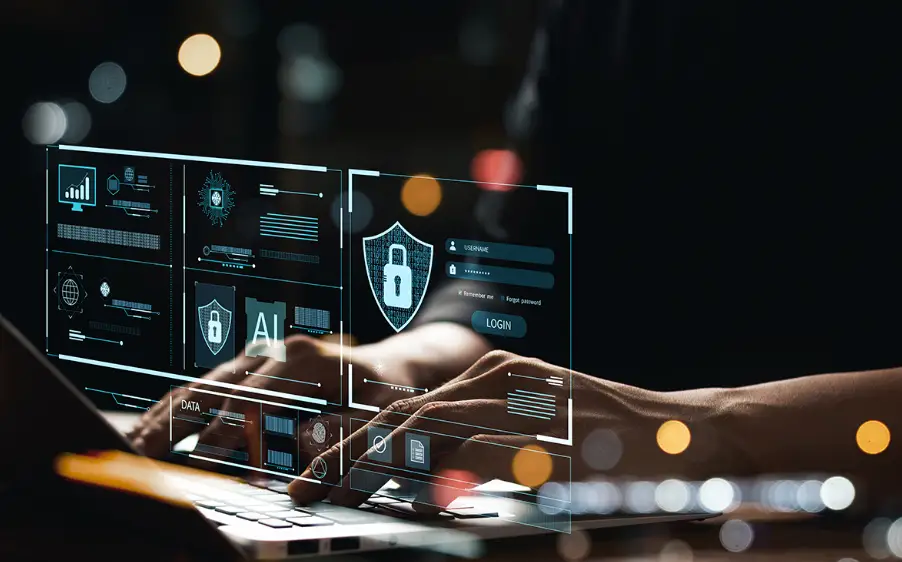Table of Contents
ToggleI. Introduction
In today’s ever-evolving digital landscape, where the heartbeat of businesses pulsates online, ensuring robust server security has become more critical than ever before. From small-scale enterprises to multinational corporations, the integrity of servers stands as the bedrock of digital operations. With hackers becoming more sophisticated and techniques constantly evolving, it is crucial for businesses to stay ahead of the curve by implementing strong server security technology measures. To learn more about the importance of server security and how you can safeguard your digital assets, visit us.
A. Brief Overview Of The Importance Of Server Security In Today’s Digital Landscape
Imagine your business as a fortress in the digital realm, with your servers as the impenetrable walls safeguarding invaluable data, customer information, and proprietary assets. Now, picture the repercussions of breaching those walls – data breaches, financial losses, tarnished reputation, and legal liabilities. This scenario vividly illustrates why server security is paramount in today’s digital landscape.
With the exponential growth of online transactions, the proliferation of cloud-based services, and the interconnectedness of devices through the Internet of Things (IoT), the attack surface for malicious actors has expanded exponentially. Cybercriminals, equipped with sophisticated tools and techniques, constantly prowl the digital realm, seeking vulnerabilities to exploit. Whether it’s stealing sensitive information, launching distributed denial-of-service (DDoS) attacks, or hijacking servers for nefarious purposes, the threats loom large and varied.
Moreover, the regulatory landscape governing data protection and privacy has become increasingly stringent. Legislation such as the General Data Protection Regulation (GDPR) and the California Consumer Privacy Act (CCPA) imposes hefty fines on organizations failing to secure sensitive data adequately. Beyond financial penalties, the reputational damage inflicted by data breaches can irreparably harm a company’s brand image, eroding consumer trust and loyalty.
II. The Evolution Of Server Security Is Characterized By Several Key Trends
Advanced Persistent Threats (APTs): Sophisticated cybercriminal syndicates and state-sponsored actors deploy APTs – stealthy, targeted attacks aimed at infiltrating networks, exfiltrating data, and maintaining persistent access. These adversaries employ social engineering, zero-day exploits, and custom malware to circumvent traditional security defenses.
Zero-Day Vulnerabilities: Zero-day vulnerabilities refer to previously unknown software flaws that hackers exploit before developers can patch them. With the proliferation of software applications and the interconnectedness of systems, identifying and mitigating zero-day vulnerabilities has become a Herculean task for cybersecurity professionals.
Ransomware and Extortion: Ransomware attacks, wherein malicious actors encrypt sensitive data and demand ransom payments for decryption keys, have emerged as a lucrative criminal enterprise. Beyond encrypting files, ransomware operators increasingly resort to data exfiltration and extortion, amplifying the financial and reputational stakes for organizations.
Cloud Security Challenges: The migration to cloud-based infrastructure offers unparalleled scalability and flexibility but introduces unique security challenges. Shared responsibility models, misconfigurations, and insider threats underscore the importance of robust cloud security measures to protect data residing in cloud environments.
In light of these evolving threats, organizations must adopt a proactive stance towards server security, embracing emerging technologies such as artificial intelligence (AI), machine learning (ML), and behavioral analytics to detect and mitigate threats in real-time.

III. Best Practices In Server Security
Ensuring robust server security technology requires a proactive and multi-faceted approach that fortifies your digital fortress against an array of cyber threats. The two fundamental pillars of server security: implementing a multi-layered security approach and maintaining regular software updates and patch management.
A. Implementing A Multi-Layered Security Approach
Just as a medieval castle employed layers of defenses – moats, walls, and towers – to repel invaders, modern server security necessitates a multi-layered defense strategy. Relying solely on a single security measure is akin to leaving a single point of failure, inviting potential breaches. Instead, organizations should deploy a combination of preventive, detective, and responsive security controls to create a formidable defense perimeter.
- Perimeter Security: Begin by fortifying the perimeter of your network with robust firewalls, intrusion detection and prevention systems (IDPS), and virtual private networks (VPNs). These technologies act as the first line of defense, filtering incoming and outgoing traffic and blocking unauthorized access attempts.
- Access Controls: Implement stringent access controls to limit user privileges and restrict unauthorized access to sensitive data and resources. Utilize role-based access control (RBAC), strong authentication mechanisms (such as multi-factor authentication), and least privilege principles to ensure that users only have access to the resources necessary for their roles.
- Data Encryption: Encrypt sensitive data both at rest and in transit to safeguard it from unauthorized disclosure or tampering. Secure Socket Layer (SSL) and Transport Layer Security (TLS) protocols encrypt data in transit, while robust encryption algorithms protect data stored on servers or in databases.
- Endpoint Security: Extend your security perimeter to endpoints, including laptops, desktops, and mobile devices, with endpoint protection solutions. Endpoint detection and response (EDR) tools provide real-time threat detection and response capabilities, mitigating the risk of malware infections and data breaches.
- Security Monitoring and Incident Response: Implement robust security monitoring solutions, such as Security Information and Event Management (SIEM) platforms, to detect anomalous behavior and security incidents in real-time.
By adopting a multi-layered security approach, organizations can create overlapping layers of defense that collectively mitigate the risk of cyber threats and bolster the resilience of their server infrastructure.
B. Regular Software Updates And Patch Management
Software vulnerabilities represent low-hanging fruit for cyber adversaries, providing entry points for exploitation and infiltration. To mitigate this risk, organizations must prioritize regular software updates and patch management as integral components of their server security strategy.
- Patch Management Process: Establish a formal patch management process to systematically identify, prioritize, and apply software patches and updates across your server infrastructure. Automated patch management tools can streamline this process, ensuring timely patch deployment without disrupting business operations.
- Vulnerability Scanning: Conduct regular vulnerability assessments and penetration testing to identify potential security weaknesses and misconfigurations within your server environment. Utilize vulnerability scanning tools to scan for known vulnerabilities and prioritize remediation efforts based on risk severity.
- Vendor and Third-Party Patching: Stay vigilant about vendor-supplied patches and security updates for your server operating systems, applications, and third-party software components. Monitor vendor security advisories and subscribe to notification services to promptly receive information about newly discovered vulnerabilities and available patches.
- Change Management: Implement robust change management processes to track and document changes to your server infrastructure, including software updates, configuration changes, and patch deployments. Maintain an accurate inventory of installed software and dependencies to facilitate effective patch management and risk assessment.
By diligently adhering to a proactive patch management regimen, organizations can minimize their exposure to known vulnerabilities and reduce the likelihood of successful cyber attacks targeting their server infrastructure.

IV. Conclusion
In navigating the ever-changing landscape of digital security technology, the imperative for organizations to fortify their server defenses has never been more critical. Throughout this we’ve delved into the intricacies of server security, exploring best practices, emerging technologies, and the evolving nature of cyber threats. One crucial aspect of securing a server is ensuring the protection of its database server, as they often contain sensitive and valuable information.
Frequently Asked Questions (FAQ)
Q: What are the main challenges in traditional server security practices?
Traditional server security measures often struggle to keep pace with evolving threats, leaving systems vulnerable to sophisticated attacks. Additionally, they may lack the agility needed to adapt to rapidly changing security landscapes.
Q: How does a multi-layered security approach improve server security?
A multi-layered security approach combines various security measures such as firewalls, intrusion detection systems, access controls, and encryption to create multiple barriers against potential threats. This approach enhances resilience and reduces the likelihood of successful breaches.
Q: What is Zero Trust Architecture (ZTA) and how does it enhance server security?
Zero Trust Architecture (ZTA) is a security model that assumes no trust by default, requiring strict verification for every user and device attempting to access resources on the network. By continuously authenticating and authorizing users and devices, ZTA minimizes the risk of unauthorized access and lateral movement within the network.
Q: How do emerging technologies like AI and machine learning contribute to server security?
AI and machine learning enable proactive threat detection and response by analyzing vast amounts of data to identify patterns indicative of malicious activity. These technologies can detect anomalies, predict potential security threats, and automate responses, thereby enhancing the overall effectiveness of server security measures.
Q: What role do containerization and microservices play in server security?
Containerization and microservices provide a more secure and scalable infrastructure by isolating applications and services from one another. This isolation minimizes the impact of security breaches and reduces the attack surface, making it harder for attackers to compromise sensitive data or disrupt operations.




